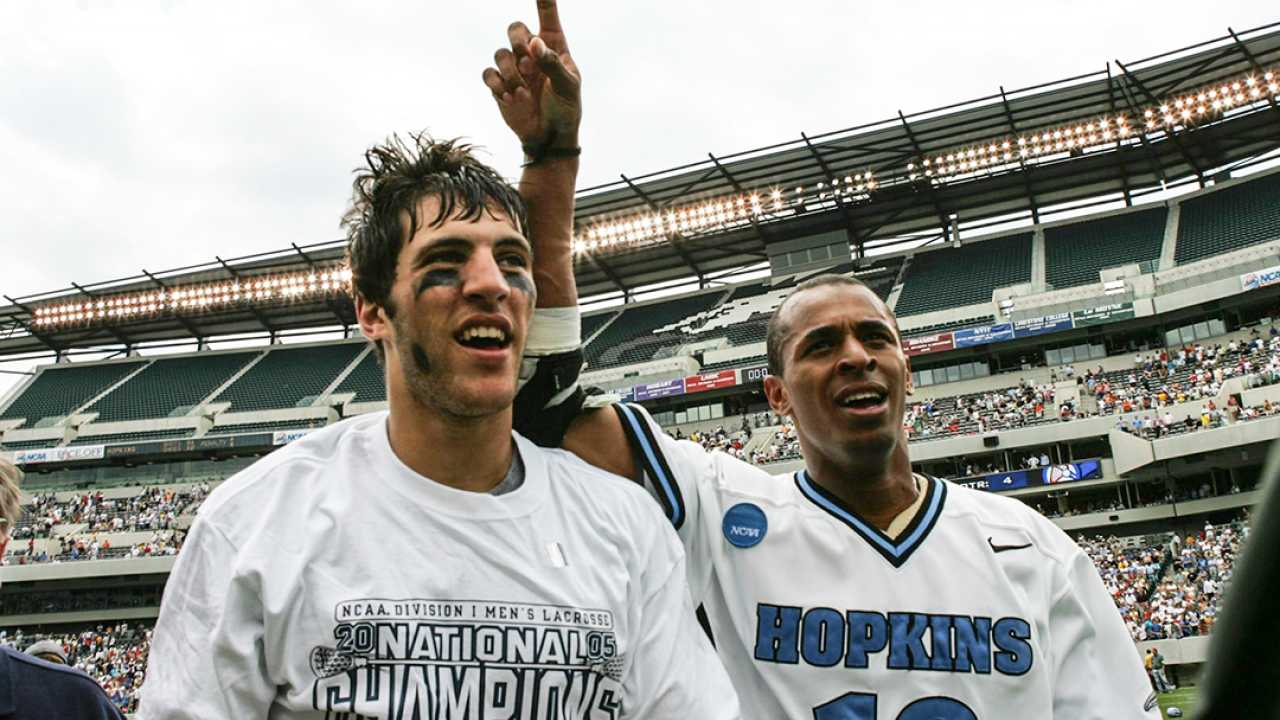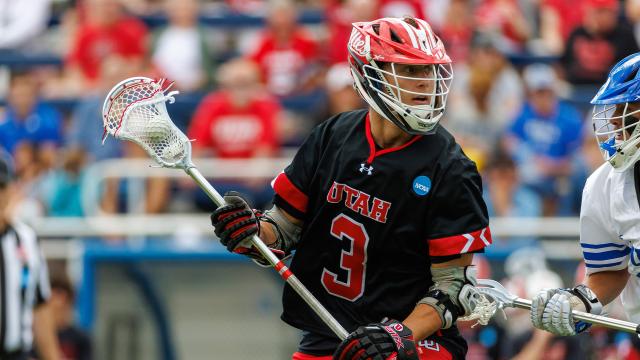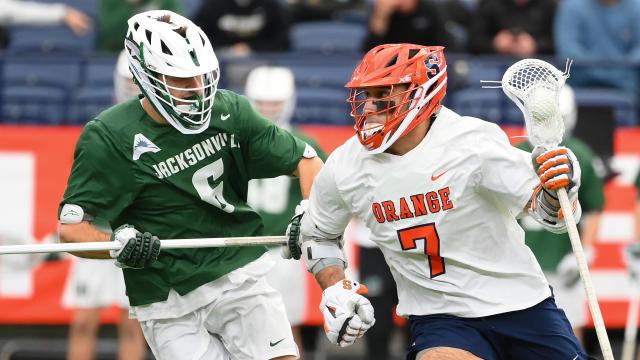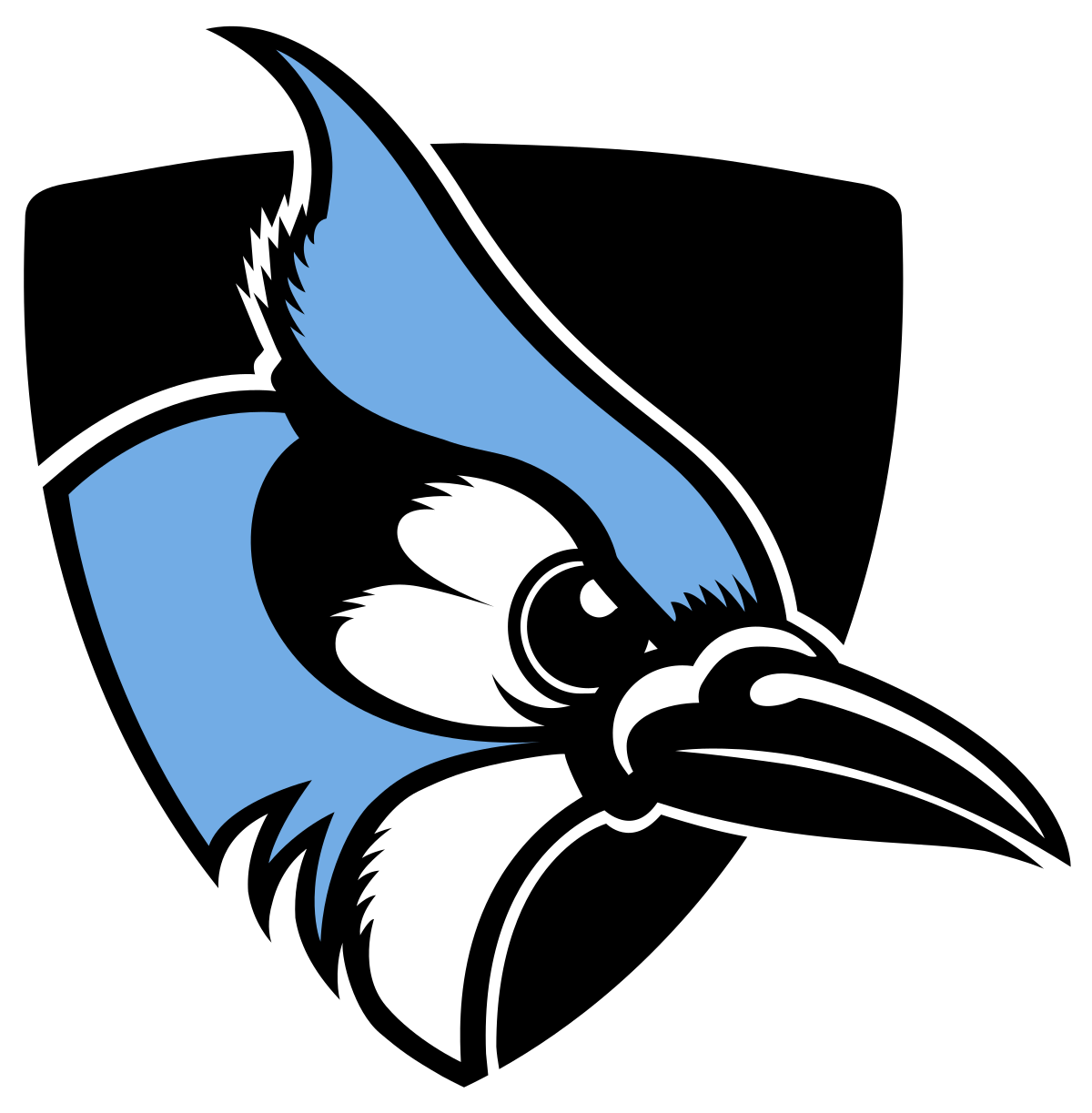
How Kyle Harrison and Paul Rabil Carried Lacrosse into the 21st Century
This year marks the 25th anniversary of USA Lacrosse. To celebrate, we’re revisiting some of our favorite magazine stories of the USA Lacrosse era on the 25th of each month.
KYLE HARRISON CREPT UPSTAIRS AT 2 A.M., surprised to see the light on in the bedroom of his off-campus residence near Johns Hopkins University in Baltimore. When he opened the door, he saw Paul Rabil posted up to the TV watching a grainy VHS of a Hopkins-Carolina lacrosse game.
Then a highly touted recruit out of D.C.-area sports superpower DeMatha, Rabil had his eye on the stack of tapes from the moment he arrived on his official visit in 2004.
“This is heaven,” Rabil thought.
When Harrison and Rabil first met, Harrison was three years into his decorated career as a Johns Hopkins midfielder. Ahead was his historic senior season, which ended with the Blue Jays finishing 16-0 and winning the school’s first NCAA championship since 1987.
Harrison finished his brilliant run at Homewood by winning the Tewarraton Award as a two-time first-team All-American. He began his professional lacrosse career as the top draft pick of Major League Lacrosse.
Back then, Rabil was a big, athletic, senior midfielder at DeMatha High School in Hyattsville, Md., on an official visit to Johns Hopkins, where Harrison had been assigned to show Rabil around and make him the guest at Harrison’s off-campus residence.
Once Rabil chose Hopkins over North Carolina, lacrosse history awaited.
Several weeks into the 2005 season, Rabil, the freshman, came off the bench to join Harrison, the senior, on the first midfield at Syracuse, where the Blue Jays were in an early 7-1 hole. Rabil scored four goals to lead a huge comeback win in overtime.
Hopkins was on its way, and so was Rabil, who played a key role in that title drive, then would lead the Blue Jays to another crown in 2007 and a near-miss in the 2008 title game. He graduated as a three-time first-team All-American.
Like Harrison, Rabil was the first pick in the MLL draft and would become the face of the pro game. Other than in 2014, when they played together for Team USA, Rabil and Harrison had not been teammates since that memorable season as Blue Jays.
Until 2018, that is.
With the formation of the Premier Lacrosse League, Rabil and his brother and co-founder, Mike, launched an ambitious, historic venture that has brought unprecedented exposure and earning opportunities for professional lacrosse players.
When the PLL was founded, Rabil hired Harrison as the league’s director of player relations. They both retired as players in 2021, Harrison with a farewell tour that included a special tribute at Homewood Field and Rabil with a surprise press conference ahead of the PLL championship game at Audi Field in Washington, D.C.
Venturing into the USA Lacrosse Magazine vault, one encounters visual proof of the duo’s immeasurable impact on the sport. Combined, they’ve appeared on the cover 10 times, including once together.
In 2018, USA Lacrosse Magazine writer Gary Lambrecht chatted with Rabil and Harrison, who still think of themselves as Blue Jays first.
What is a vivid memory you guys have from Paul’s recruiting visit?
HARRISON
Paul already was widely known as a guy who was going to be the next big thing in lacrosse — unlike me in high school. I let him use my bedroom, so I slept on the couch. One night, I came up to my room around 2 a.m. to get something I’d forgotten. I was surprised to see a light on in the room. Paul was watching film of a Hopkins-Carolina game. It was clear he was very driven. It made perfect sense why we were so interested in bringing him to Hopkins.
RABIL
That was the first time I’d ever seen a Hopkins-Carolina game. The only way to watch lacrosse at that time, other than seeing final four games that might have been televised, was on VHS tapes. I noticed earlier that night that Kyle had this huge stack, including tapes of every Hopkins game from the [2004] season. I was like, “Oh, my gosh, this is heaven.” So I just started throwing them in and watching.
How much time did you spend together the year you teamed up?
HARRISON
We constantly worked together. Whether we were shooting extra, playing wall ball, watching film, practicing, Paul was next to me. On game days, we’d be out there two hours early, dodging, throwing back to each other, shooting. We didn’t talk to each other at times like that. We’d just work then head to the locker room to get ready [for the game].
RABIL
Once I came on campus, Kyle always kept an eye out for me and still does to a degree today. We ran every team sprint side-by-side in practice, and I lost every time to him. I realize now that [as a freshman] I was just beginning to explore what it really meant to work hard. Kyle was my mentor and best friend on that team. He alleviated pressure that was on me. I got to play against short-stick [defenders], because all eyes were on Kyle. I had house money that year.
There are so many great moments, regarding that special 2005 season. Let’s go back to the 12-11, come-from-behind overtime win at Syracuse on that Friday night in mid-March.
RABIL
I had been getting a good share of shifts with the second midfield, but getting called up to play with Kyle and Greg Peyser [on the first line] with us down 7-1 was … whoa. I remember my first shot went in, and they just started dropping. When I scored the game-tying goal off a wing dodge with under two minutes left [in regulation], it felt like I could shoot with my eyes closed.
HARRISON
When Paul bumped up to the first midfield, our offense became un-guardable. Trying to cover Paul with a short stick in college, well, that just wasn’t possible. He walked onto our campus shooting it well with either hand on the run from 13, 14 yards, which is a true rarity for a young player at that level. He was so big he could take a check, get underneath his man and score. He was very good, very early, and he just took over that [Syracuse] game. Our season changed.
How much have your separate professional paths prepared for this reunion at this stage of your careers?
HARRISON
Paul and I are fortunate in that we’ve been pro lacrosse players from the get-go. Because of the sponsors and partners we’ve had, we’ve been able to do this full-time. We’ve stayed in touch, but everything up until now has been a competition, right down to our sponsors and partners. There hadn’t been much to navigate together. But we used to talk a lot about how something would make sense one day for us to do together.
RABIL
We’ve always been very committed to this game and to helping to grow this game, while we’ve been running on our separate paths. We’ve acquired lots of business knowledge along the way. Since 2005, there have probably been gaps of six months where we haven’t talked at all. But when you have that kind of trust with somebody, you re-engage really quickly. It’s like you pick up a conversation exactly where you left off every time.
When the plan for this venture started to take root, was it inevitable that you guys would come full circle and work together?
RABIL
There is a saying in business that advises you don’t want to mix business with family and friends. But with something this size, and with the potential and many challenges it has, I beg to differ. When I think of our relationship, chemistry is the word that comes to mind. You can’t take something like this on without surrounding yourself with people you love and trust and have spent a large part of your life and career around.
HARRISON
Last January, when we were both in town for the annual [US Lacrosse] convention, we hadn’t connected for months, but we made sure to set aside a couple of hours to do that. That’s when Paul told me about this idea. I was really excited about it for two reasons. It’s the best thing for the future of the men’s game. And Paul and I can finally collaborate on something again. We’ve been working in parallel universes for years.
Despite the closeness of your ages, how different is your feel for social media?
HARRISON
Paul is just a few years younger than me, but when he graduated from Hopkins [in 2008], he was right at the heart of social media’s emergence. He started using Facebook, YouTube, Instagram, everything, as a young pro. He’s done an incredible job of growing his brand through that. I sort of came from a different time.
RABIL
I’m not sure there is anybody better in our sport in front of a camera than Kyle. He’s incredibly empathic and motivating and can speak to so many people. I’ve always enjoyed media and marketing. If I wasn’t a player, I probably would have gone right into that full-time. I love it in the same way Kyle loves writing — still the most impressionable form of art. I remember when I first took pictures and videos of workout sessions and pushed them out on social media. Any lacrosse fan could consume it right away. A light bulb went on for me.
Paul, you get the last word. Is it possible to quantify how much your time at Hopkins put you on the path that has led you and your old teammate to this exciting point as professionals?
RABIL
It’s probably more of a philosophical question. But if I didn’t go to Johns Hopkins and experience everything from my time with Kyle and Coach [Dave] Pietramala, to the college experience in the game’s most storied program, to having the chance to play for three national championships, to learning so much in the trenches about the game, I’m not sure this would have happened. In terms of an appetite for the sport, Hopkins unlocked so much for me.
We made history together. Let’s ignite our future. Together.
Matt DaSilva and Gary Lambrecht
Related Articles




